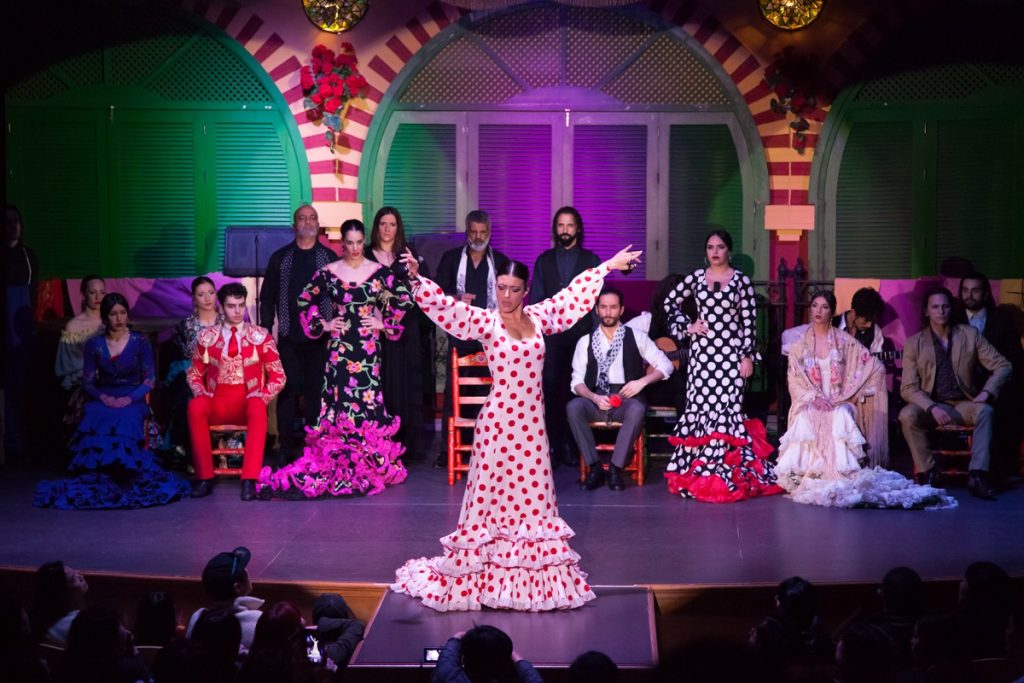
As its name suggests, alegrías (joys) is one of the most festive styles of flamenco. It has its origin in the province of Cádiz, being one of the oldest genres, and many consider it as the most important style. It belongs to the cantiñas family, traditional songs from the province of Cádiz.
Alegrías is one of the oldest flamenco dance in this art and has influenced many other styles. Perhaps the most characteristic feature is its rhythm, which it shares with the soleá, although the most significant and which makes this style recognizable, especially for the least understood, is the “tirititrán, trán, trán” with which cante begins.
The alegrías is a flamenco style that is nourished by other styles such as the panaderos, the coplas romanceadas, the seguiriyas, the rosas (other types of cantiñas), the old fandangos from Cádiz and the jaleos. Although the fundamental basis of the alegrías are the jotas, specifically Navarran-Aragonese, a genre that came to Cádiz during the French occupation.
It is for this reason that the original letters of this flamenco style alluded to the Virgen del Pilar, the Ebro river and Navarra. In this way the jota from Cádiz emerged, a style that has evolved to become the joys, as we know them today.
An example of those primitive alegrías is the one interpreted by “La Niña de los Peines”, entitled “I hit the boatman hard,” the lyrics of which read:
“Yo le di un duro al barquero
Por pasar el Ebro a verte.
Yo le di un duro al barquero
Los amores de Navarro,
Son caros pero son buenos”.
“I gave the boatman a penny
For passing the Ebro to see you.
I gave the boatman a penny
The loves of Navarro,
They are expensive but they are good”
By the 19th century, these “jotas de Cádiz” began to flatter, approaching the rhythms of the soleá. This favors a differentiation from the rest of the flamenco styles of the time, which tended to be more dramatic.
Singers like Paco Hidalgo or El Quiqui did a lot for the evolution of this style, which was finally called alegrías, because of the way they referred to it when they were going to interpret it, as “happy song” and “for happy”.
At the end of the 19th century, it was Enrique El Mellizo, who molded this style to the flamenco form that we recognize today, pointing the way forward to future singers such as Romero El Tito, José Ortega ‘El Águila’, Gabriela Ortega or Macaca, among others . What it did was slow down its rhythm so it could be sung.
Enrique Butrón fixed the flamenco form of this cante (singing), while Ignacio Ezpeleta introduced the famous “tiriti, trán, trán trán” at the beginning of it, an expression that makes it recognizable from other flamenco styles. Its compass is similar to that of the soleás, although with a more cheerful tone than these.
As for the structure, the alegrías has four octosyllabic verses, which can be linked to the playful (letters that complement the singings by cantiñas) of three or four verses, following the wake of the classical seguiriya, formed by a couplet and chorus.
The alegrías dance turns out to be the one with the greatest flamenco tradition and serves as a reference for other flamenco styles when it comes to starting their own choreography. It is considered one of the oldest flamenco dance. The intermittent character of the beat of this genre makes it unmistakable, making it one of the most attractive dances in flamenco art.
The structure of this dance consists of the exit, the calls, shifts between letters, a brush with tapping and a singing silence in which castanets take center stage. The alegrías end with an outing in displeasure or bulerías in jaleos.
In this video, you can get an idea of what alegrías dancing is like:
The first recording of this flamenco style took place more than 100 years ago, specifically in 1909 by Sebastián El Pena, who defines his cante as jaleo, a genre that derives directly from the historical cantiñas of Cádiz. He was accompanied on guitar by “El Hijo del Ciego” and at the dance by Juana Vargas, better known as “La Macarrona”.
Regarding the field of flamenco guitar, Paco de Lucía has been a great leader in this genre, starring in a before and after with his work “La Barrosa”, a song recorded on his album “Siroco” in 1986.
In a flamenco show, alegrías is a festive singing, which encourages dancing, thanks to its fast, happy and boisterous rhythm. An invitation to enjoy the most traditional flamenco.
© 2024 El Palacio Andaluz. All rights reserved.